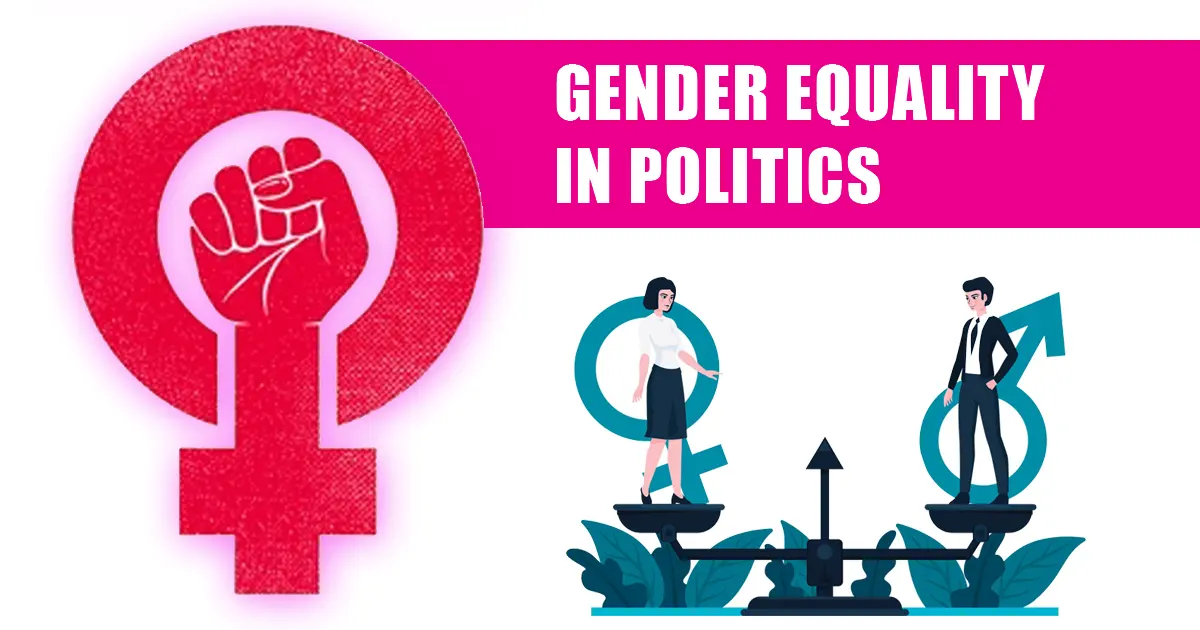
Context (IE)
In 2024, India’s democracy stands at a critical juncture, where increasing female participation in political roles is essential to diversify decision-making, enrich policy discussions, and mature the democratic process.
India’s Legacy in Women’s Political Empowerment
- Early Voting Rights:
India was among the pioneering nations to grant women equal voting rights, establishing a foundational principle of gender inclusivity in its democracy. - Historical Figures of Shakti:
Women like Uda Devi Pasi and Dakshayani Velayudhan played pivotal roles in shaping India’s political and social landscape, demonstrating courage and leadership during key moments in history. - Cultural Significance:
The concept of Ardhanarishvara in Indian culture symbolizes the balance and equality between genders, reinforcing the notion that gender balance in political roles is crucial for a harmonious society.
Progress for Women in Indian Politics
- Nari Shakti Vandan Adhiniyam Bill (2023):
This law encourages increased female representation in decision-making processes, facilitating a more gender-diverse political sphere. - Substantive Participation:
Women in India have progressed from ceremonial roles to influential positions, shaping electoral strategies and advocating for women-centric policies like Beti Bachao Beti Padhao and Jan Dhan Yojana. - Breaking Political Stereotypes:
Women across various political parties have transitioned from symbolic to substantive roles, setting a powerful example for a more inclusive democracy.
Importance of Women’s Political Participation
- Democratic Integrity:
Women’s involvement in politics strengthens democratic systems by ensuring diverse voices are heard and promoting more balanced governance. - Gender-sensitive Policies:
Women leaders bring a focus on issues affecting women, children, and marginalized groups, leading to policies in healthcare, education, and economic security that benefit all citizens. - Enhanced Community Engagement:
Female political leaders often have stronger grassroots connections, ensuring policies reflect the real needs of communities. - Societal Transformation:
More women in politics challenge traditional gender norms, inspiring future generations of women to break barriers and assume leadership positions. - Economic and Social Development:
Research shows that regions led by women often see better infrastructure, enhanced educational outcomes, and more efficient project implementation. - Meeting Global Commitments:
Greater female participation aligns with the United Nations Sustainable Development Goal 5, which focuses on achieving gender equality.
Current Status in India
- Parliamentary Representation:
Women’s representation in the Lok Sabha has increased from 4.4% in 1952 to 14.4% in 2019. In the 2024 elections, a record 74 women MPs were elected, with many being first-time entrants. - State Legislatures:
At the state level, female representation remains lower, with states like Chhattisgarh (14.4%) and West Bengal (13.7%) leading but still falling short of ideal targets. - Global Comparison:
India’s female parliamentary representation is lower than countries like Rwanda (61.3%) and Sweden (47.3%), which demonstrate significantly higher rates of female political representation.
Measures Supporting Women’s Political Empowerment
- Constitutional Provisions
- Article 15 prohibits discrimination based on sex, affirming women’s equal rights.
- Article 243D reserves 33% of seats for women in Panchayati Raj Institutions.
- Article 326 guarantees the right to vote for all adults, including women.
- Legislative Initiatives
- The Nari Shakti Vandan Adhiniyam (2023) ensures 33% reservation for women in the Lok Sabha and state assemblies.
- Constitutional Amendments (73rd and 74th) mandate 33% reservation for women in rural and urban local bodies, with some states opting for 50%.
- International Treaties and Commitments
- CEDAW (1979) promotes women’s rights in political and public life.
- The Beijing Platform for Action advocates for the removal of barriers to women’s political participation.
Challenges to Women’s Political Participation
- Patriarchal Norms:
Deep-rooted gender roles and societal conditioning often restrict women’s political ambitions, emphasizing domestic roles over public leadership. - High Campaign Costs:
The financial burden of running competitive political campaigns remains a significant barrier for many women entering politics. - Political Bias:
Male-dominated political parties frequently display bias, limiting opportunities for women candidates and offering fewer party tickets to women. - Safety and Security Risks:
Women in politics face the threat of harassment and violence, which often deters their active involvement. - Proxy Representation:
In local governance, the practice of Sarpanch Pati—where male family members act as de facto leaders in place of elected women—undermines true female empowerment.
Global Best Practices
- Zipper System (Rwanda):
This system mandates that every third candidate on political party lists be female, resulting in Rwanda having one of the highest rates of female parliamentary representation globally. - Constitutional Committees (Chile):
Chile’s policies ensure balanced gender representation in committees, promoting gender-equitable decision-making. - European Quota Systems:
Countries like Switzerland have implemented effective gender quotas, significantly improving female representation in legislative bodies.
Measures for Enhanced Female Representation
- International Engagement and Commitment:
India should align with international frameworks such as the G20 Leaders’ Declaration and SDGs, reaffirming women’s political empowerment as a global priority. - Electoral Reforms:
Addressing challenges like criminalization and financial irregularities can level the playing field, making political participation more accessible for women. - Gender-Inclusive Policies:
Political structures need gender-responsive frameworks that ensure equal access to political leadership for women. - Intra-Party Democracy:
Political parties should actively encourage the participation of women at all levels, from local to national elections. - Local-Level Representation:
Strengthening female participation in local governance through grassroots organizations and Self-Help Groups can build a pipeline of future political leaders. - Support Women-Led Initiatives:
Promoting women-led projects in areas like social welfare and sustainability can drive systemic change. - Political Education and Leadership Training:
Developing mentorship and leadership programs for young women will help empower them, enhancing their political participation and fostering gender equality.




